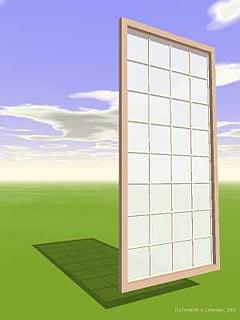The construction:
The grid of the frame is realizised by vertical and horizontal
thin boxes, which were placed by a while loop.
The thin boxes consist by 2 different colored boxes, one with a lighter and the other with a darker
shade of the same texture - this makes the grid much more sculptural in those cases while it's
lightened only by indirect light (ambient), as somewere in the shadow.
// ------------------------------------
#declare Shoji_WoodTX =
texture{
pigment{ color LightWood*1.5
quick_color White}
finish { difffuse 0.85 phong 1}}
// for visible yz surfaces
#declare Shoji_WoodTY =
texture{
pigment{ color LightWood*1.45
quick_color White}
finish { difffuse 0.85 phong 1}}
// for visible xz surfaces
#macro HortS(Dx,Dy,Dz)
#local D = 0.0001; // just a little bit !!
union{
box{ <D,D,D>,< Dx-D,Dy-D,Dz >
texture{Shoji_WoodTX}}
// dies ist die sichtbare yz-Oberfgläche
box{ <D,D,D>,< Dx-D,Dy ,Dz-D>
texture{Shoji_WoodTY}}
// dies ist die sichtbare xz-Oberfgläche
} #end // --------------------------------
Semitransparent paper by "material":
To make visible the casting of shadows it's necessary to use
"caustics" in the "interior" statment of the "material"
container.
// -------------------------------------
#declare Shoji_M =
material{
texture { pigment{
color White filter 0.27
quick_color White}
normal {bumps 0.1 scale 0.002}
finish {diffuse 0.9
phong 0.5}
}// end of texture
interior{caustics 0.002
}// end of interior
}// end of material --------------------
The complete Shoji element is formed by a
"union" of two objects defined as "macros":
1. the paperwall with the inner grid:
#macro Shoji(WideX,WideY,XNr,YNr)
// XNr = number of segments in x direction
// YNr = number of segments in y direction
2. the wooden outer frame:
#macro Window1(WideX, WideY,FrameXY,FrameZ)
// FrameXY = the thickness of the frame in x and y
// Frame Z = the thickness of the frame in z
|
A Shoji Element
Click here for the scene description
for POV-Ray:
".txt" file or
".pov" file
|

